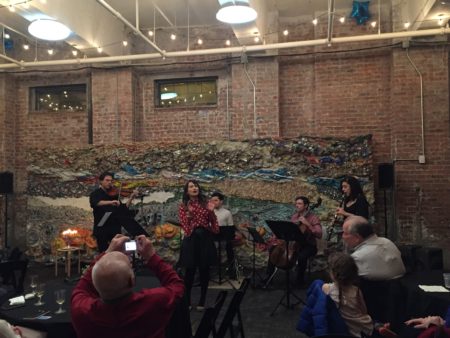Ladino 101
By Natasha Mayer
On Saturday December 8th, the seventh night of Hanukkah, I attended a Klezmer music concert at JCC Harlem, which JWFNY had the honor of cosponsoring. During this concert, the music was a mix of traditional Hebrew, English language, and Ladino. Like many of you, I was familiar with the Hanukkah earworm “Ocho Kandelikas,” but until last week, I knew nothing about Ladino, the Judeo-Spanish language in which it’s sung. Some online research later that week helped me to learn more about Ladino, and to celebrate learning more about the diversity of Jewish cultures, here’s a six-point primer for absolute beginners:
- The Ladino language is primarily derived from pre-16th century Spanish, with heavy Hebrew influences, primarily around Jewish tradition and religious observation. Mediterranean and Sephardic Jews were the primary speakers.
- Jews were expelled from Spain in 1492. Spanish Jews settled throughout Europe and the Middle East, leading to Ladino’s evolution to include elements from Turkish, Arabic, and French languages as well. It was only earlier this year that Spain began recognizing Ladino as a Spanish tongue. Officials from the Royal Spanish Academy are now working on establishing a Ladino academy in Israel with the goal of preserving this little-spoken language.
- There are numerous reasons a language can become endangered, from speakers gradually shifting to a different language and not passing the original down to their children, to use of the language being discouraged or even disallowed by the government or society, to the genocide of the primary speakers. An estimated 90% Ladino-speaking Jews were murdered in the Holocaust, leading to the United Nations agency UNESCO classifying Ladino as “seriously endangered.”
- In 1996, the Israeli Knesset passed a law to found the Israel National Authority of Ladino. It publishes a Ladino magazine called Aki Yerushalayim for the Sephardic community and diaspora.
- Like Yiddish, Ladino is experiencing a small resurgence in the academic community. While more American universities offer Yiddish learning due to Ashkenazi heritage of many American Jews, Tufts University and the University of Pennsylvania now offer Ladino courses through their language departments. In Israel, Hebrew University, Bar-Ilan University, and Ben-Gurion University offer Ladino learning as well.
- Ladino has growing support in the music world as well. Yasmin Levy, an Israeli folk singer, mixes traditional Ladino music with a flamenco beat to great acclaim. Brooklyn-based duo La Mar Enfortuna releases modern interpretations of traditional Sephardic music, including Ladino songs, as well as songs in Arabic, Aramaic, Greek, and English.
Since learning more about Ladino, my appreciation for the enormous multiplicity of Jewish cultures worldwide has only grown. By learning more about the many Jewish cultures, traditions, and languages, we can create a truly welcoming community for Jews around the world, and here at home in New York.
To learn more about Ladino, watch Professor Aron Rodrigue’s lecture at the Arizona Center for Judaic Studies. Yasmin Levy’s passionate Ladino vocals cannot be missed. Check her out on Australian National Radio!

